Willdenowia incurvata
Willdenowia incurvata (Thunb.) H.P.Linder
Family: Restionaceae
Common names: sonkwas restio (Eng.); sonkwasriet (Afr.)
Introduction
This is a tough, densely tufted plant that can be used as an accent plant and is ideal for fynbos gardens. The plants produce attractive brown bracts during the autumn-winter flowering period and smooth brown fruits.
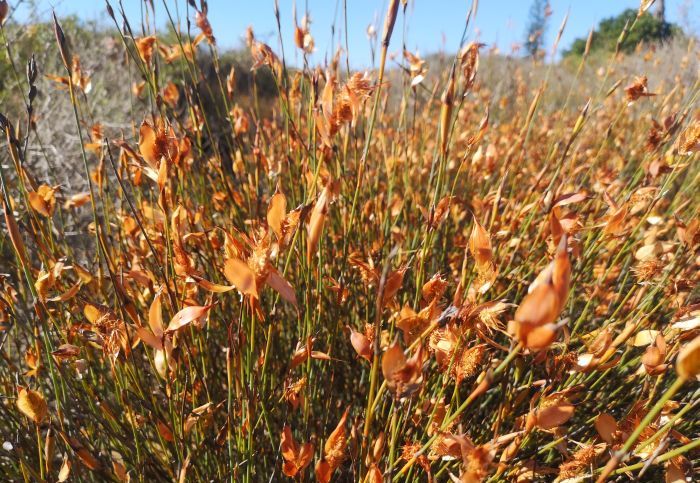
Description
Description
Willdenowia incurvata is an evergreen, perennial, grass-like restio that grows 0.5 to 1.5 m high and up to 3 m wide. Plants have short rhizomes and make a base of 0.3–3 m in diameter. Culms are branched, curved inwards and striped; brown sheaths loosely convoluted.
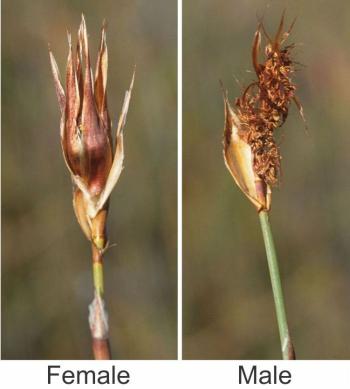
The inflorescences of male and female plants are slightly different. The male inflorescence has numerous spikelets with large spathes, and bracts of 4–17 mm long, which are taller than the 2.5 mm long flowers. The female inflorescence is a solitary spikelet (occasionally 2 spikelets), with 5–10 bracts of 10–35 mm long, which are taller than the 7–10 mm long flowers. The flowers are produced in autumn to early winter (April, May or June).

Seeds are released in early summer (October or November). The nut seeds are 7–9 mm long and 5–6 mm in diameter, brown, elliptical in shape, with a smooth apex and a pitted wall.
Conservation Status
Status
Willdenowia incurvata is assessed as Least Concern (LC) on Red List of South African plants. The expansion of rooibos tea farms is a threat in many areas.
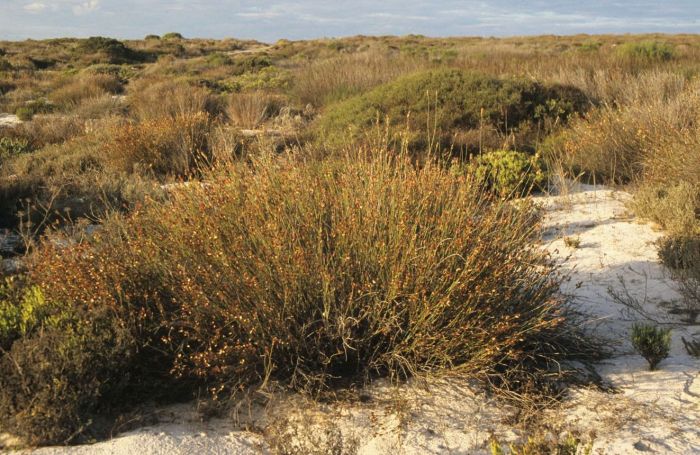
Distribution and habitat
Distribution description
Willdenowia incurvata is widely distributed, occurring from False Bay in the Western Cape to Springbok in Namaqualand, in the Northern Cape. This species grows on sandy coastal flats and sandy plains, on deep, well-drained acidic sands. It also occasionally occurs on the coastal sands, sandy valleys and lower slopes of the mountains between the Cape Peninsula, Clanwilliam and the Hex River Valley. It is dominant in the Sandveld between Melkbos and Olifants River, from sea level to 1 200 m altitude range.
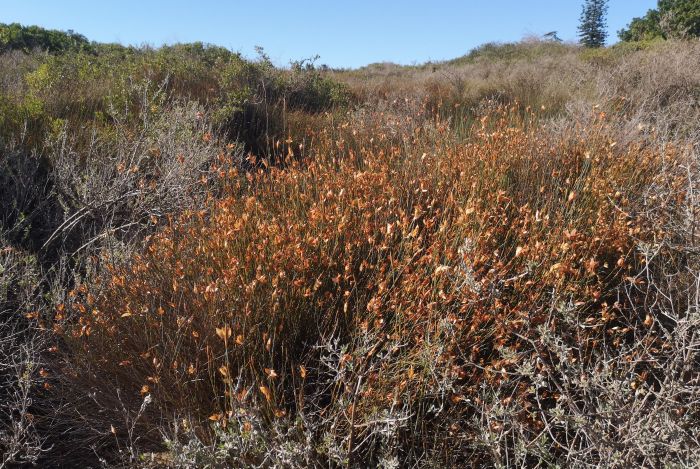
Derivation of name and historical aspects
History
Willdenowia is one of the genera in the family of Restionaceae. The genus is endemic in the fynbos region of South Africa. The genus Willdenowia was named to honour Captain Ludwig Willdenow, 1765–1812, a German botanist who amassed plant specimens for an important herbarium. The species name incurvata is derived from the Latin incurvatus, which means ‘curved inwards’.
Willdenowia currently has 12 recognized species in southern Africa and 2 occur in Namaqualand.
The name Restionaceae is derived from the Latin word restis, which means ‘rope’ or ‘cord’ and alludes to the use of these plants in southern Africa. Restionaceae is the family name of the restios (Cape reeds). Restionaceae has 400 species in about 40 genera and most of the species occur in winter rainfall regions on poor sandy soils in South Africa and Australia, with a few outliers in the north of Africa, Madagascar, Indo-China and Chile.
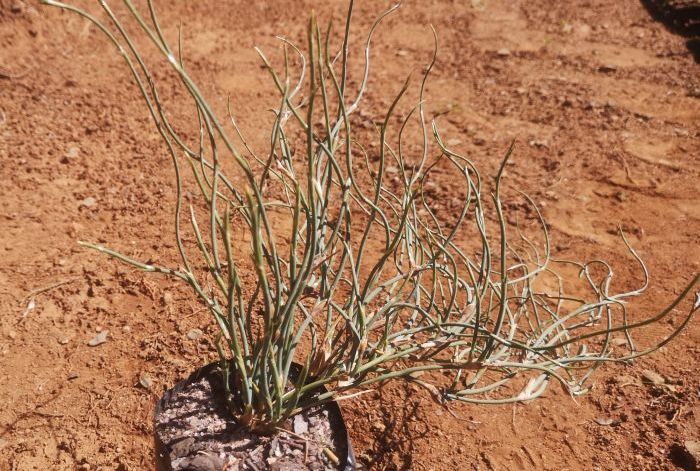
Ecology
Ecology
Willdenowia incurvata is a reseeder, which means the plant is killed by fire and the population re-establishes through seeds. However, some survive fires, and several observations of resprouted plants have been reported. After harvesting or fire, people in Melkkraal who often burn the restio fields to make way for rooibos tea farms, have observed the plants resprouting.
Willdenowia incurvata is dioecious (male and female flowers are born on separate plants). The seeds are without an elaiosome (which attract ants that feed on it and disperse the seed). The seeds of Willdenowia incurvata are dispersed by the rodent, Gerbilliscus paeba. They feed on or consume the seed during the night and disperse the seeds.
This species is heavily grazed by cattle which feed on the female nuts and male inflorescences and don’t eat the lower culms, thus giving cattle-grazed tussocks a rounded look.
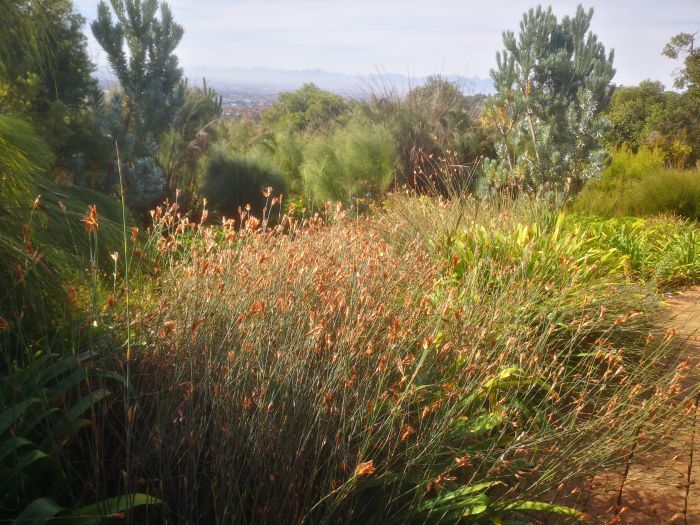
Uses
Use
In the Western Cape and Northern Cape, the culms are rarely used for thatching rooves and are commonly used to make brooms.
This is a spectacular plant that can be planted in small or large fynbos gardens and is ideal for windy sandy gardens. In a small garden, group 2 to 3 plants a metre apart and fill up between them with Restio festuciformis, which will last for 4 to 5 years in a garden. In larger gardens, plant it either in a border or as a large group with companions, such as species of Agapanthus and Cannomois grandis, and Leucadendron argenteum in the background, for silvery colour.
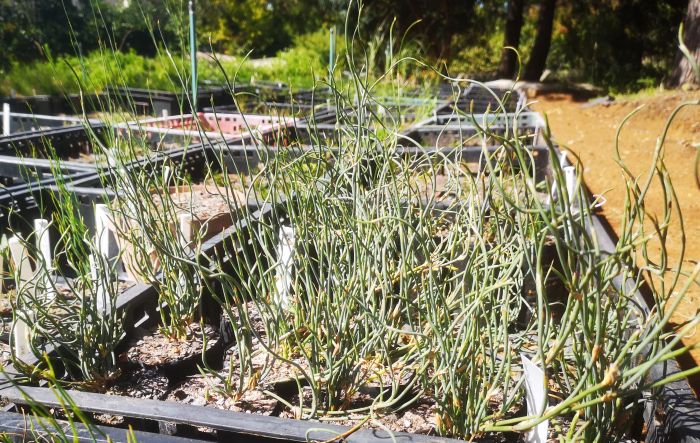
Growing Willdenowia incurvata
Grow
The propagation of Willdenowia incurvata is done by seed. The seeds are sown in the early winter season when the night temperature drops to 5–10ºC and the day temperature is 15–20ºC. The seeds are laid on well-drained fynbos soil and covered with a fine fynbos mixture. The seed takes about 6 weeks to germinate. Feed the seedlings with organic fertilizer during the growing season, to prevent yellowish and unhealthy plants. Keep your seedlings moist, not dry or too wet.

The germination rate of the seed is low. Seeds treated with smoke derived from dry and wet fynbos plants material, has proven to have a very small effect on the germination rate on Willdenowia incurvata. The studies indicated that smoke treated seed should be used with other germination cues, to break seed dormancy and stimulate the germination.
Seedlings are ready to plant in the open ground after a period of 2 years. Plant the Willdenowia incurvata in a well-drained soil, full sun, in a group to get the beautiful texture of brown sheaths of male and female inflorescence. Plants in the garden need very little maintenance, without pruning or feeding or removal of old growth. New plants need to be watered during the first 2 years after planting and much less once the plants are established.
References
- Brown, N., Jamieson, H. & Botha, P. 1998. Grow restios. Kirstenbosch Gardening Series. National Botanical Institute, Cape Town.
- Brown, N.A.C. & Duncan, G.D. 2006. Grow fynbos plants. Kirstenbosch Gardening Series. South African National Biodiversity Institute, Cape Town.
- Dorrat-Haaksma, E. & Linder, P.H. 2012. Restios of the fynbos. Struik Nature, Cape Town.
- Harvey, William H. (1811–1866). Restionaceae. Flora capensis: being a systematic description of the plants of the Cape colony, Caffraria, & Port Natal (and neighbouring territories). Reeve, London
- Le Roux, A. 2005. Namaqualand. South African Wild Flower Guide 1. Botanical Society of South Africa, Cape Town.
- Linder, H.P. 2011. The African Restionaceae: an IntKey identification and description system. Version 6. Contributions from the Bolus Herbarium 19.
- Linder, H.P. 1985. A conspectus of the African Species of Restionaceae. Bothalia 15 : 3-4.|
- Velembo, S. 2015. Willdenowia teres Thunb. (Restionaceae). PlantZAfrica. Internet 7pp. http://pza.sanbi.org/willdenowia-teres.
- Vlok, J. & Schutte-Vlok, A-L. 2015. Plants of the Klein Karoo. Umdaus Press, Hatfield.
- Watson, J. 2004. Is the use of Willdenowia incurvata (Restionaceae) for construction at Melkkraal in the Northern Cape sustainable? (Honours thesis). Botany Dept. University of Cape Town.
- Weighill, B. 2017. Rodents and restios: rodents and the fates of Willdenowia incurvata (Restionaceae) seeds. (Masters of Science thesis). Stellenbosch University.
Credits
Mashudu Nndanduleni
Kirstenbosch National Botanical Garden
June 2019
Plant Attributes:
Plant Type: Restio
SA Distribution: Northern Cape, Western Cape
Soil type: Sandy
Flowering season: Autumn, Winter
PH: Acid
Flower colour: Brown
Aspect: Full Sun
Gardening skill: Challenging
Special Features:
Horticultural zones








Rate this article
Article well written and informative
Rate this plant
Is this an interesting plant?
User Comments
Chris Jones, Portugal
July 07, 2019 at 8:12 AMGood photos showing plant with, and without leaves.
Informative description of what restio means ... Latin for cord or rope, due to use in SA.
Login to add your Comment
Back to topNot registered yet? Click here to register.